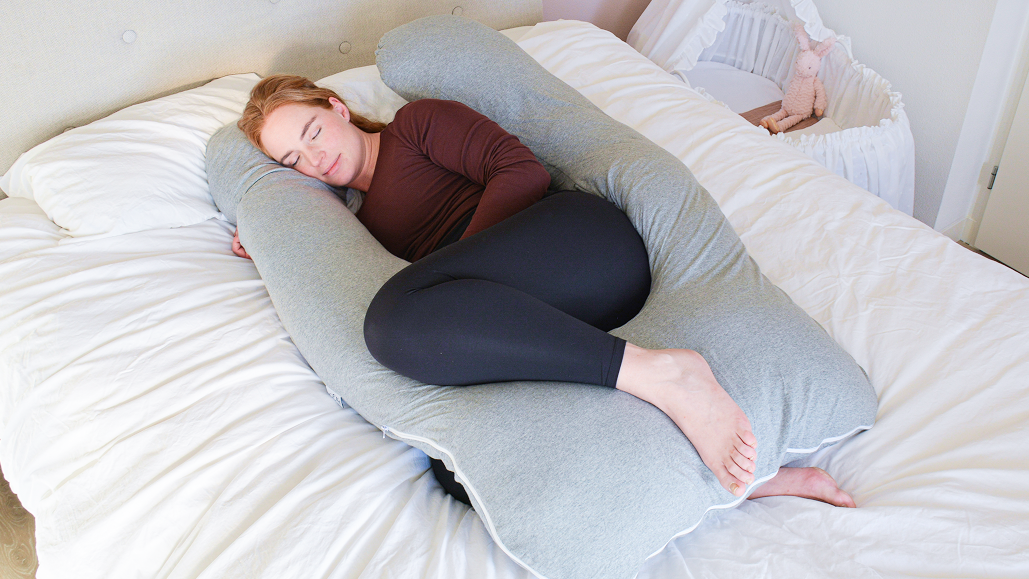
7 Reasons to Sleep with a Pregnancy Pillow
Share
7 Reasons Why Sleeping with a Pregnancy Pillow Will Change Your Night
Good news: with sleeping with a pregnancy pillow, comfortable lying during your pregnancy suddenly becomes much more achievable. Many expectant mothers experience back, hip, and pelvic complaints. A smartly designed pregnancy pillow distributes pressure, supports belly and back, improves circulation, and helps you lie more stably—allowing you to sleep deeper and turn less. In this guide, you will read 7 concrete reasons, plus tips to choose the best pregnancy pillow for your body and sleeping position.
What is a pregnancy pillow?
A pregnancy pillow is an ergonomic support pillow that grows with your body and is designed for nighttime comfort. It cushions pressure points, promotes neutral alignment of spine and pelvis, and stabilizes your side position. Want to read the basic principle calmly first? See: What is a pregnancy pillow?
Types of pregnancy pillows
- U-shape: 360° support for head, back, and belly; ideal for frequent turning.
- C-shape: flexible wrapping, easy to position around belly and legs.
- Wedge pillow: compact and targeted; slide it under the belly or in your lower back.
Why is good sleep during pregnancy so important?
Calm, deep sleep supports energy, mood, and recovery—for you and your baby. Hormonal changes, growing belly, and pressure on joints make sleeping through the night difficult. This is where a pregnancy pillow comes in: it helps your body relax and prevents unnecessary pressure. Also read: Why a pregnancy pillow?
7 Reasons to choose a pregnancy pillow
1. Relief for back pain
By neutrally supporting your spine, a pillow reduces muscle tension in the lower back. It supports the weight of your belly so you don't force an arched back and your paraspinal muscles have to compensate less.
2. Support for the hips
Place the pillow between your knees; this keeps hips and pelvis aligned. Less shifting means less pressure pain on the outer hip and SI joint—great for longer nights.
3. Better circulation
A stable side position prevents pinching of large vessels and nerves. Result: less tingling arms or "sleeping" legs. This supports deep, restorative sleep cycles.
4. Extra support for the belly
The growing belly requires support. With targeted support, you reduce pressure on uterine ligaments and abdominal wall. This feels immediately calmer, especially in the 2nd and 3rd trimesters. Tip: increase comfort and hygiene with a cover for your pregnancy pillow.
5. Less tossing and turning at night
Because your body is already “in position,” you need to search less for a posture. The chance of waking up due to discomfort decreases, and you get longer, uninterrupted sleep blocks.
6. Helps with pelvic instability
By symmetrical support, you relieve the pelvis and limit rotational movements that can trigger pain. Especially with instability, controlled support is a gamechanger.
7. Lasting comfort after pregnancy
Handy: a pregnancy pillow remains useful during the postpartum period. It functions as a nursing pillow for ergonomic feeding, and as support during recovery rest. You can read more practical experiences in Sleeping after childbirth: how a pregnancy pillow really helps.
Choosing the best pregnancy pillow
The best pregnancy pillow matches your height, mattress, and favorite sleeping position. Note:
- Shape: U-shape for maximum all-round support; C-shape for flexibility; wedge for targeted support.
- Material & cover: breathable (cotton/bamboo), washable and preferably soft-skin-touch. Consider an extra cover for hygiene.
- Filling: microfiber (softer, “plushy”) or foam/beads (shape-retaining); choose what feels good for your body.
- Care: check washing instructions and zipper quality for durable use.
Ready to compare? View the full selection: best pregnancy pillow – collection. Or go directly to a popular model: pregnancy pillow product page.

Tips for optimal use of a pregnancy pillow
- Side sleeping – preferably left: supports circulation and relieves the back.
- Knee-to-knee support: keep knees and ankles aligned to prevent pelvic rotation.
- Add back support: wedge a pillow behind your back to avoid 'rolling back'.
- Combine with the right mattress: medium-firm helps reduce pressure point pain.
- Hygiene: use a washable cover; wash frequently if night sweating.
Experiences from other mothers
Many mothers report that pregnancy pillow sleeping feels immediately calmer: less pressure on lower back and hips, less waking from turning, and noticeably deeper sleep. After childbirth, they appreciate the continued use as a nursing and support pillow. For real-life insights: read this article.

Frequently asked questions about pregnancy pillows
- 1. When do you start using a pregnancy pillow?
- Many start in the 2nd trimester; earlier if you already have back, hip, or pelvic pain.
- 2. Does it help with back and pelvic pain?
- Yes. By aligning the spine and pelvis, pressure points decrease and pain often lessens.
- 3. Is a pregnancy pillow still useful after childbirth?
- Absolutely. It works as an ergonomic nursing pillow and support during recovery.
- 4. Which shape is the most comfortable?
- Personally. Try U-shape (full embrace), C-shape (flexible), or a wedge (targeted).
- 5. How do I keep my pillow hygienic?
- Use a washable cover and follow the manufacturer's washing instructions.
- 6. What is the difference with a “regular” nursing pillow?
- A pregnancy pillow is larger and designed for nighttime body support; a nursing pillow is more compact for feeding and positioning.
Conclusion: your key to better sleep
A well-fitting pregnancy pillow relieves back, hip, and pelvic pain, supports your belly and back, promotes circulation, and helps you turn less at night—so you sleep deeper and more peacefully. Ready for the difference? Compare the selection with the best pregnancy pillow directly via the collection page or check out a popular pregnancy pillow.




